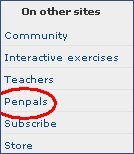|
|
|
|
|
|
|
| Key pals | |
|
One of the bigest advantages the internet can bring to our teaching is the possibility to expand the walls of our classroom. Thus, we can communicate with people from any other country and exchange all aspects of a language and a culture, or carry out a joint project of research. The possibilities are almost unlimited. Keypals add a note of motivation to our student's writing. They make the language significative by providing practice and putting the emphasis on communication, leaving aside - only to some extent, of course - the idea of grammar and structure we are still so keen on. In this practice we will explore websites that offer keypals and learn ways to set up an exchange with another school. |
|
| Practice it! | |
|
|
1. |

If you prefer, you can post your message and wait for someone to write to you. |
|
| 2. It is also interesting to make your students create their own account - for free - at this site. Once they're logged in, they can make their own personal welcome page, create a city guide or a fan page. All they need to do is fill in the forms with the required information and the page is generated automatically. They may also send e-cards, participate in forums and do some interactive activities. Any of these provide excellent reading and writing practice. | |
|
|
If you are a subscriber of the print magazine, check its-english for interactive exercises or 3sixty5 and its-teachers for teachers resources (you will need the subscriber's ID and password that comes with the paid subscription). |
|
3. A good example of a classroom exchange is The Image of the Other. It is a very successful project by European Schools Project in which students exchange information, data, viewpoints, etc., on many different subjects via email. In the portal teachers will find everything they need to put the project into practice:
|
|
|
|
|
|
The Pupil's pages are accessed from the Teacher's page. They contain the instructions for each letter the students exchange in web or printable versions. In the first letters, the students' writing is controlled, they just fill in the blanks to complete their letter. Little by little, as they get more familiar with letter-writing, the messages become more open, and the pupils are just given a few useful words and guidelines. |
|
| Activity framework | |
|
|
| Additional info | |
|
Some hints and readings on keypal exchange: http://sookmyung.ac.kr/~miran916/keypal.htm |
|